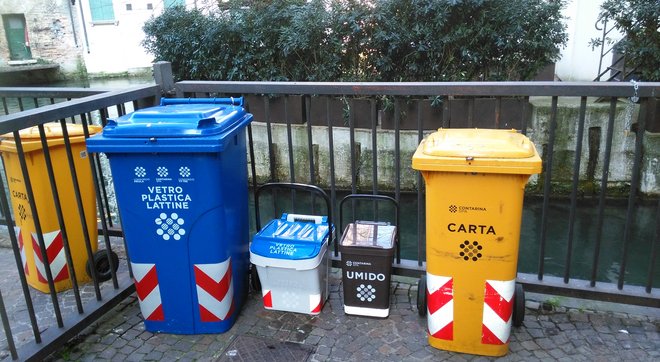Getting to know global best practices in sustainable waste management
From 11 to 14 March Zelena akcija/Friends of the Earth Croatia took part in a specialist study visit to Italy organised by the NGO Sunce from Split. The aim was to learn about global best practices in sustainable waste management based on the waste hierarchy – in other words, waste prevention, separated collection, recycling and composting.
Our destination was the Veneto region, which with its 4.9 million inhabitants and 580 local administrations (cities and districts) is a roughly similar size to Croatia. However the difference is that in Croatia around 15% of waste is collected separately, whereas in Veneto it is over 80%. For this reason, the region is an ideal example of best practice which could be applied to cities and districts in Croatia, especially as the area is physically similar, with plains, mountains and coastal areas.
The first location visited was the in-vessel compost facility with a capacity of 280 000 tonnes per year in the town of Maniago which from organic waste produces 70 000 tonnes of compost that are used in agriculture. In addition, 32 000 MWh of electrical energy are generated annually from bio-gas from anaerobic digestion and are used to supply the local population. A series of similar composters of smaller capacity across Croatia would be able to efficiently deal with organic waste without harmful environmental impacts, and could be financed by EU funds.
The next stop was the district of Ponte nelle Alpi, which with its 9500 inhabitants is larger than 86% of Croatian districts and towns, and which separately collects 92% of its total waste, making it a world leader. If such a simple system was applied to the aforementioned 86% of districts and towns in Croatia, a large portion of the waste problem would be solved. The most important elements of such successes are the identification of users, ensuring containers are adjusted to the needs of each individual household and payment by amount of mixed waste. Such a system motivates people to separate waste and adopt a rational approach to waste since those who separate waste have lower bills than those who deal with their waste irresponsibly. The success of this district is even greater considering that the system was rolled out in just 9 months. As well as a high percentage of separation, other success indicators are the fact that the monthly bills for those who separate waste are 30% lower than with the previous system, and that dozens of people are employed. The communal waste company has a stable income and has rationalised its costs due to reduced needs for waste collection and landfilling and additional income from selling the separately collected fraction for recycling.
Trevisio was chosen as an example of a larger city which together with its suburbs totals around 550 000 inhabitants. They separate more than 85% of total waste thanks to an efficient system of small containers in every household, like that of the smaller district of Ponte nelle Alpi. In Treviso we visited a newly-built sorting facility of 63 000 tonnes oer year which will soon start operating and sort the non-separated waste for placing on the recyclables market. The price of the sorting facility is HRK 37 million, which is small change compared to the planned incinerator in Zagreb which is projected to cost HRK 2.75 billion. In addition, such a facility can easily be co-financed from EU funds, which is not the case with an incinerator. This sorting facility is an example of a series of similar ones across Italy, which efficiently deal with residual waste from which organic waste has already been separated at source.
The sites we visited show that with a properly set-up system, a high percentage of recycling can be achieved in a short time period. What is needed is a good strategy and a system which is based on respecting the waste hierarchy. Investing in infrastructure for at-source waste separation (bins and bags with electronic chips), composting facilities and sorting facilities is also needed, as well as quality education for the public about the importance of separating waste and the possibility of influencing one's monthly bills in this way. Incineration of waste and construction of oversized waste management centres that result in 'fuel' for incineration must be avoided.
Having learned from these examples, we call on the Ministry of Environmental and Nature Protection to ensure, in the new Waste Management Plan for the Republic of Croatia, due to be approved this year, a legal framework in which towns and districts in Croatia can implement a system based on separated collection, recycling and composting. Likewise, we call on local authorities to implement such systems in line with the aforementioned best practices.
Presentations from the study visit can be found here and photographs from the study visit here.
